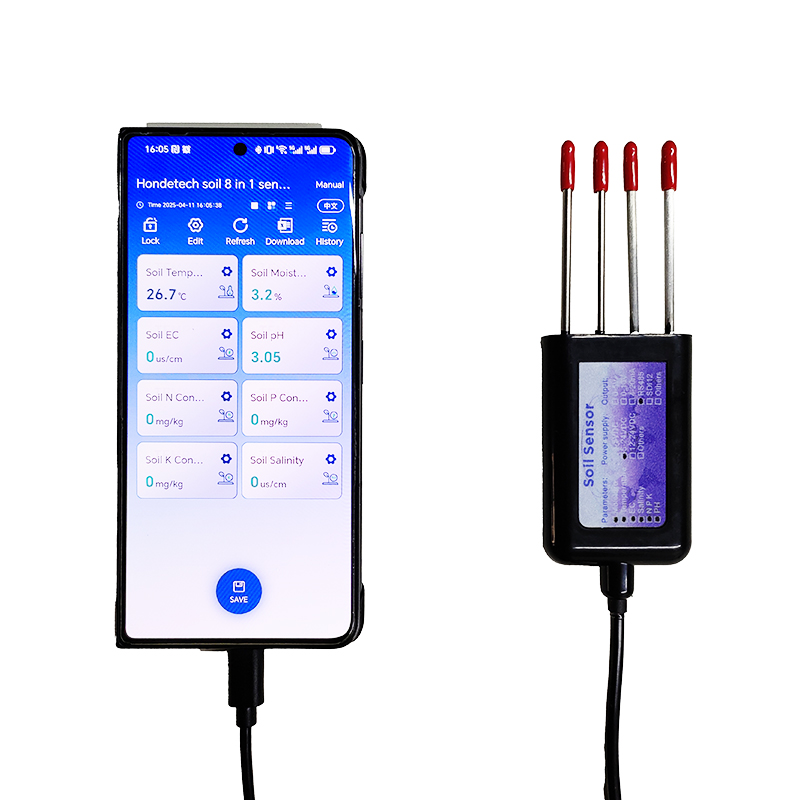Pandan popilasyon mondyal la ap kontinye grandi, defi pwodiksyon agrikòl la ap vin pi grav. Pou satisfè demann k ap grandi pou manje, kiltivatè yo bezwen ijan jwenn metòd jesyon agrikòl efikas ak dirab. Capteur tè a ak aplikasyon telefòn mobil ki mache avè l la te vin an vigè, bay yon solisyon entelijan pou agrikilti modèn. Atik sa a pral prezante benefis capteur tè yo, kijan pou itilize yo, epi montre kijan teknoloji avanse sa yo ka amelyore sede ak kalite rekòt yo.
Ki sa ki yon detèktè tè?
Yon detèktè tè se yon aparèy yo itilize pou kontwole anviwònman tè a an tan reyèl, anjeneral li mezire imidite tè a, tanperati, pH, ak kontni eleman nitritif (tankou azòt, fosfò, potasyòm, elatriye). Detèktè sa yo transmèt done san fil nan yon smartphone oswa yon aplikasyon òdinatè, sa ki pèmèt kiltivatè yo wè done an tan reyèl nenpòt ki lè, nenpòt kote, pou ede yo pran desizyon syantifik.
Benefis detèktè tè yo
siveyans done an tan reyèl
Detèktè tè yo ka kolekte done sou eta tè a an tan reyèl, ke kiltivatè yo ka jwenn aksè a nenpòt ki lè atravè aplikasyon an pou yo swiv sante tè a.
Jesyon irigasyon presizyon
Lè yo analize done imidite tè a, kiltivatè yo ka aplike irigasyon presi epi redwi gaspiyaj dlo. Olye pou yo konte sou eksperyans oswa previzyon metewolojik, irigasyon an baze sou kondisyon tè reyèl yo.
Ogmante sede rekòt la
Lè kiltivatè yo siveye kontni eleman nitritif ki nan tè a, yo pi byen kapab kontwole rejim fètilizasyon yo pou asire ke rekòt yo resevwa eleman nitritif ki pi apwopriye yo, kidonk ogmante kwasans ak sede rekòt yo.
Avètisman pou ensèk nuizib ak maladi
Gen kèk detèktè tè avanse ki ka kontwole aktivite mikwòb tè a ak lòt endikatè enpòtan pou ede detekte siy bonè ensèk nuizib ak maladi epi redwi pèt rekòt.
Dirablite ekolojik
Itilizasyon detèktè tè ak aplikasyon ka ankouraje devlopman agrikilti ekolojik, diminye itilizasyon angrè ak pestisid, epi amelyore dirabilite agrikilti a.
Kouman pou mwen itilize detèktè ak aplikasyon tè yo?
Etap 1: Chwazi bon detèktè tè a
Chwazi bon detèktè tè a pou bezwen agrikòl ou yo. Gen kèk detèktè ki pi byen adapte pou ti jaden lakay, alòske gen lòt ki fèt pou gwo tè agrikòl. Verifye distans siveyans detèktè a, presizyon li, ak koneksyon san fil li.
Etap 2: Enstale Capteur a
Selon enstriksyon pwodwi a, yo enstale detèktè a nan jaden kote yo bezwen siveye li. Pi bon pratik la se mete plizyè detèktè nan diferan anviwònman tè, tankou limyè solèy dirèk ak lonbraj, pou jwenn done konplè.
Etap 3: Telechaje aplikasyon an
Telechaje APP la sou telefòn entelijan ou oswa tablèt ou.
Etap 4: siveyans an tan reyèl ak analiz done
Apre ou fin konekte detèktè a ak aplikasyon an, ou ka wè endikatè tè yo an tan reyèl. Analize done yo regilyèman epi ajiste plan irigasyon ak fètilizasyon yo selon previzyon metewolojik ak bezwen rekòt yo.
Etap 5: Pran yon desizyon syantifik
Pran desizyon enfòme sou fèm ou yo ki baze sou done an tan reyèl, tankou ki lè pou irige, fètilize epi plante. Sa ap ede ou maksimize resous ou yo epi amelyore sede ak kalite rekòt yo.
Egzanp an pwen: Istwa siksè agrikilti entelijan
Ka 1:
Yon kiltivatè pòm nan Kore di Sid te konn jije kilè pou irige selon eksperyans li, sa ki te lakòz gaspiyaj resous ak kwasans pyebwa inegal. Depi li enstale detèktè tè a, li te kapab kontwole imidite tè a, pH ak kontni eleman nitritif yo an tan reyèl. Avèk done aplikasyon an bay yo, li posib pou kontwole irigasyon an avèk presizyon epi aplike bon kantite angrè. Kòm rezilta, pwodiksyon pòm li ogmante de 30%, fwi yo te pi plen, repons mache a te ekselan, epi revni fèm nan ogmante anpil.
Ka 2
Yon fèm legim òganik nan Ostrali amelyore itilizasyon tè a tout pandan l ap kenbe kalite li. Gras a itilizasyon detèktè tè, yo ka byen konprann eleman nitritif tè yo alè, sa evite twòp fètilizasyon, kidonk kenbe ekoloji natirèl tè a. Depi yo itilize sistèm sa a, legim yo pwodui yo pa sèlman gen yon gou pi bon gou, men yo vin pi rekonèt pa konsomatè yo, e lavant yo pi fasil.
Konklizyon
Detektè tè ak aplikasyon ki mache avèk yo ap vin zouti enpòtan nan agrikilti modèn, bay kiltivatè yo done siveyans tè an tan reyèl ak egzat pou ede yo optimize desizyon agrikòl yo. Lè w aplike teknoloji avanse sa yo, ou ka pa sèlman amelyore sede ak kalite rekòt ou yo, men tou kontribye nan konsèvasyon dlo ak devlopman dirab. Monte sou tren agrikilti entelijan an jodi a pou amelyore konpetans jesyon fèm ou pou yon avni ki pi efikas.
Pou plis enfòmasyon sou detèktè a,
Tanpri kontakte Honde Technology Co., LTD.
Telefòn: +86-15210548582
Email: info@hondetech.com
Sitwèb konpayi an:www.hondetechco.com
Dat piblikasyon: 14 avril 2025


